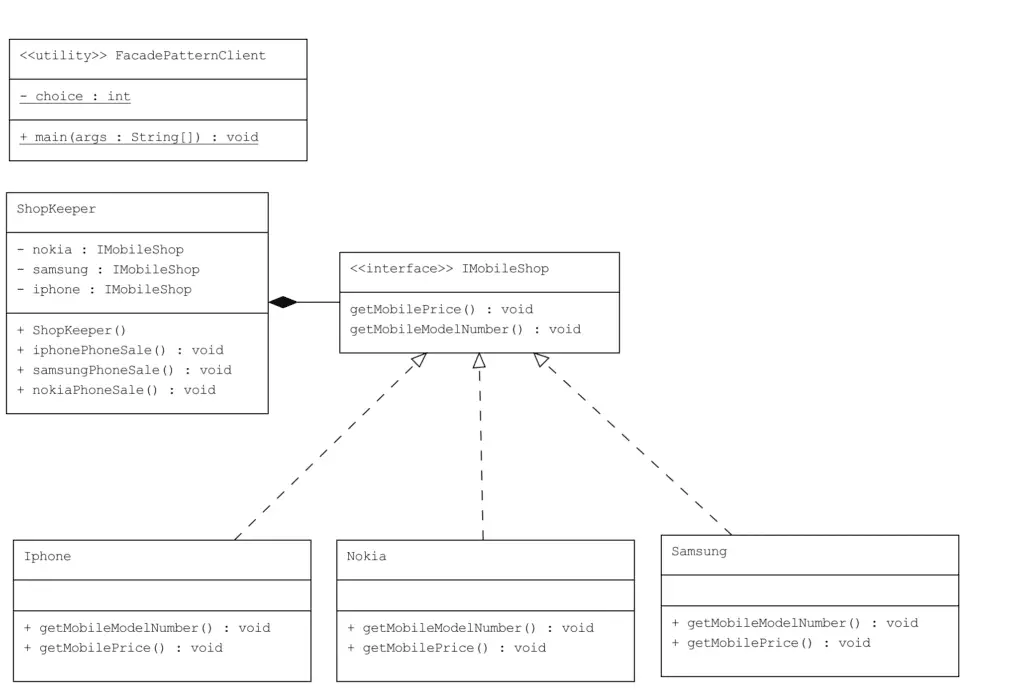Table Of Content

You, as a client want access to different menus of different restaurants. You just have access to a hotel keeper who knows his hotel well. Whichever menu you want, you tell the hotel keeper and he takes it out of the respective restaurants and hands it over to you. The Facade Design Pattern in C# is actually an extra class (i.e., a Wrapper class or, you can say, Facade Class) that sits at the top of the above classes. Please have a look at the following diagram for a better understanding. Let us understand the Facade Design Pattern in C# with one Real-Time Example.
Design Patterns — A quick guide to Facade pattern.
Directly interacting with these classes could be challenging, but introducing a BankingFacade class simplifies the process. ShapeMaker class uses the concrete classes to delegate user calls to these classes. FacadePatternDemo, our demo class, will use ShapeMaker class to show the results. In this example, the Facade pattern simplifies interaction with a complex video conversion framework. Having a facade is handy when you need to integrate your app with a sophisticated library that has dozens of features, but you just need a tiny bit of its functionality.
Meet the Incredible, Unsung Hero: Facade Pattern C#
This maintains the system’s modularity and makes it easier to update or replace parts of the system. The BankingFacade class in the example above simplifies the process of making a transaction, wrapping the interaction with multiple classes into a single method. This system might have multiple classes to handle customer accounts, transactions, audits, etc.
Types of Behvioural Patterns
Here are the facade trends that defined the past decade - The Architect's Newspaper
Here are the facade trends that defined the past decade.
Posted: Fri, 27 May 2022 07:00:00 GMT [source]
The ATM acts like a facade consuming multiple devices and sub-systems that as a client I do not have to directly deal with. Strategy patterns support object-based programming with a design pattern specialized in the behavior of software. By outsourcing code elements, independent strategies emerge that can be reused and exchanged with other solution methods at any time.
Implementing the Facade Pattern in Java
In the example above, the Facade simplifies the interaction by abstracting the underlying complexities, making the code more readable and maintainable. Remember, it’s not necessary to encapsulate every class with a Facade. Overuse can lead to an overly complicated design, which defeats the pattern’s purpose.
What is the difference between Factory Method and Facade patterns?

There is a very good real-life example of the pattern - The car starter engine. The Facade pattern is widely used in many modern Java frameworks. The Facade pattern is also useful in a microservices architecture.
Once the Payment is Successful, we need to send the Payment Invoice to the customer, and for this, we will use the Invoice System. So, create a class file named Invoice.cs and copy and paste the following code. This class has a method called Sendinvoice to send the invoice. Sometimes, we are also sending the Payment Failed Invoice to the client. The following Invoice class can accept the request from the Facade class or the client directly.
Design patterns for microservices - Microsoft
Design patterns for microservices.
Posted: Wed, 05 Jul 2017 07:00:00 GMT [source]
The Nitty-Gritty of Facade Pattern
Provide a unified interface to a set of interfaces in a subsystem. Facade Pattern defines a higher-level interface that makes the subsystem easier to use. Facade Design Pattern is one of the Structural design patterns (such as Adapter pattern and Decorator pattern).

Practical example of facade pattern implementation
It just provides a simple interface (or layer) to make our life easier. We are free to expose any functionality of the subsystem or the whole subsystem itself. Imagine a scenario where you have a complex subsystem with numerous interdependent classes.
The facade pattern is appropriate when we have a complex system that we want to expose to clients in a simplified way. Its purpose is to hide internal complexity behind a single interface that appears simple from the outside. Facade Method Design Pattern is a part of the Gang of Four design patterns and it is categorized under Structural design patterns. It hides the complexity of the underlying system and provides a simple interface that clients can use to interact with the system. The facade class is a "wrapper" that contains a set of members that are easily understood and simple to use.
In this example, we are creating a report generator which has multiple steps to create any report. For example, it shall first create report header, footer, add data rows, format the report and then write the report in desirable format (pdf, html, etc). Instead, they should delegate tasks to the appropriate subsystem classes. It’s an excellent tool for certain situations, but it might not be the best choice for all scenarios. Using the Facade pattern where it’s not needed can lead to unnecessary abstraction and complexity. While we have established a solid understanding of the Facade design pattern and its usage in Java, let's further delve into some intricacies.
In addition, concrete classes are generated which implement the interface as well as facade classes called “ShapeMaker”, which are responsible for delegating client queries. The facade design pattern is connected to specific programming languages. The pattern is typically used with C++, C#, JavaScript, Java, PHP, and Python. The following facade pattern example is based on Java and taken from tutorialspoint.com. Composite is a structural design pattern that allows us to treat individual objects and compositions ...
Facade design pattern is used to help client applications to easily interact with the system. For instance, an app that uploads short funny videos with cats to social media could potentially use a professional video conversion library. However, all that it really needs is a class with the single method encode(filename, format). After creating such a class and connecting it with the video conversion library, you’ll have your first facade. The client is given just one interface and can access only that. Once you make sure the Product is available, you need to do the Payment, and for this, we will use the Payment Subsystem.
It involves creating a facade class that represents a higher-level, unified interface to a set of interfaces in a subsystem. This pattern hides the complexities of the subsystem and provides a simpler interface for the client code. This pattern hides the complexities of the larger system and provides a simpler interface to the client. It typically involves a single wrapper class that contains a set of members required by the client. These members access the system on behalf of the facade client and hide the implementation details. Facade pattern is one of structural design pattern among other Gang of Four design patterns.
Here, in this article, I try to explain the Facade Design Pattern in C# with Examples. I hope you understand the need and use of Facade Design Patterns in C# with Examples. So you're working on a new software project and about to reach the testing phase.That's great news! But have you considered the different testing types you need to perform?

No comments:
Post a Comment